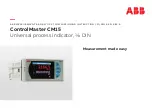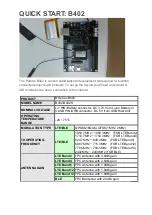
switch can be printed to the screen with the command, MG _LFx or MG _LFx. This prints the
value of the limit switch operands for the 'x' axis. The logic state of the limit switches can also be
interrogated with the TS command. For more details on TS see the Command Reference.
Home Switch Input
Homing inputs are designed to provide mechanical reference points for a motion control
application. A transition in the state of a Home input alerts the controller that a particular
reference point has been reached by a moving part in the motion control system. A reference point
can be a point in space or an encoder index pulse.
The Home input detects any transition in the state of the switch and toggles between logic states 0
and 1 at every transition. A transition in the logic state of the Home input will cause the controller
to execute a homing routine specified by the user.
There are three homing routines supported by the DMC-1600: Find Edge (FE), Find Index (FI),
and Standard Home (HM).
The Find Edge routine is initiated by the command sequence: FEX <return>, BGX <return>. The
Find Edge routine will cause the motor to accelerate, then slew at constant speed until a transition
is detected in the logic state of the Home input. The direction of the FE motion is dependent on
the state of the home switch. High level causes forward motion. The motor will then decelerate to
a stop. The acceleration rate, deceleration rate and slew speed are specified by the user, prior to
the movement, using the commands AC, DC, and SP.
It is recommended that a high deceleration
value be used so the motor will decelerate rapidly after sensing the Home switch.
The Find Index routine is initiated by the command sequence: FIX <return>, BGX <return>. Find
Index will cause the motor to accelerate to the user-defined slew speed (SP) at a rate specified by
the user with the AC command and slew until the controller senses a change in the index pulse
signal from low to high. The motor then decelerates to a stop at the rate previously specified by
the user with the DC command.
Although Find Index is an option for homing, it is not dependent
upon a transition in the logic state of the Home input, but instead is dependent upon a transition in
the level of the index pulse signal.
The Standard Homing routine is initiated by the sequence of commands HMX <return>, BGX
<return>. Standard Homing is a combination of Find Edge and Find Index homing. Initiating the
standard homing routine will cause the motor to slew until a transition is detected in the logic state
of the Home input. The motor will accelerate at the rate specified by the command, AC, up to the
slew speed. After detecting the transition in the logic state on the Home Input, the motor will
decelerate to a stop at the rate specified by the command, DC. After the motor has decelerated to
a stop, it switches direction and approaches the transition point at the speed of 256 counts/sec.
When the logic state changes again, the motor moves forward (in the direction of increasing
encoder count) at the same speed, until the controller senses the index pulse. After detection, it
decelerates to a stop and defines this position as 0. The logic state of the Home input can be
interrogated with the command MG _HMX. This command returns a 0 or 1 if the logic state is
low or high, respectively. The state of the Home input can also be interrogated indirectly with the
TS command.
For examples and further information about Homing, see command HM, FI, FE of the Command
Reference and the section entitled ‘Homing’ in the Programming Motion Section of this manual.
Abort Input
The function of the Abort input is to immediately stop the controller upon transition of the logic
state.
NOTE:
The response of the abort input is significantly different from the response of an
activated limit switch. When the abort input is activated, the controller stops generating motion
DMC-1600
Chapter 3 Connecting Hardware
•
33















































